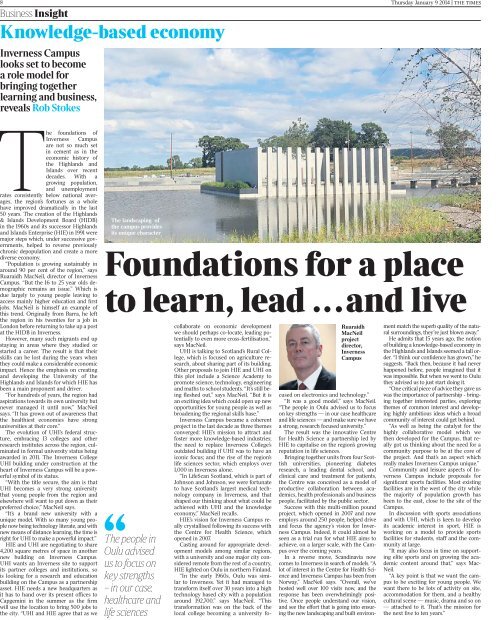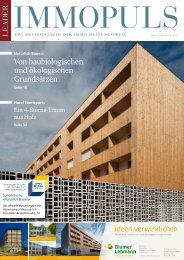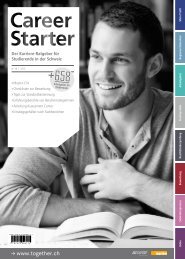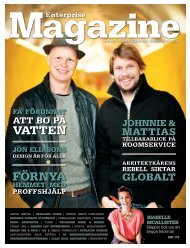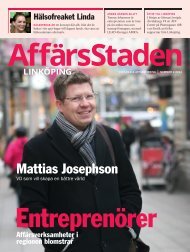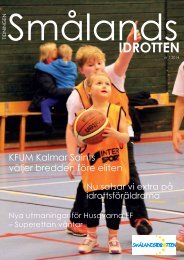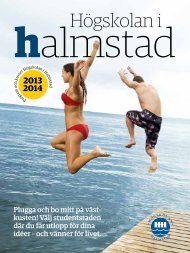Business Insight
The Highlands are a place of opportunity, the best place in the world to live and work, says Drew Hendry, leader of Highland Council. In this issue we look at the investment and vision creating this opportunity across the region. We start our journey in Inverness and at Inverness Campus, one of the largest projects that Highlands and Islands Enterprise (HIE) has embarked upon and one that is being hailed as a project of national importance. Brendan Dick, head of BT Scotland, discusses next generation broadband (NGB), its complexities and how it will benefit the people and businesses of the Highlands and Islands. We also go north to Caithness and Sutherland and discover why the run-down of nuclear activity is creating major opportunities for the area.
The Highlands are a place
of opportunity, the best
place in the world to live
and work, says Drew
Hendry, leader of Highland
Council. In this issue we
look at the investment and
vision creating this opportunity
across the region.
We start our journey in
Inverness and at Inverness
Campus, one of the largest
projects that Highlands and
Islands Enterprise (HIE)
has embarked upon and
one that is being hailed as
a project of national importance.
Brendan Dick, head of BT
Scotland, discusses next
generation broadband
(NGB), its complexities
and how it will benefit the
people and businesses of
the Highlands and Islands.
We also go north to
Caithness and Sutherland
and discover why the
run-down of nuclear
activity is creating major
opportunities for the area.
Create successful ePaper yourself
Turn your PDF publications into a flip-book with our unique Google optimized e-Paper software.
8<br />
<strong>Business</strong> <strong>Insight</strong><br />
Knowledge-based economy<br />
Inverness Campus<br />
looks set to become<br />
a role model for<br />
bringing together<br />
learning and business,<br />
reveals Rob Stokes<br />
Thursday January 9 2014 | the times<br />
he foundations of<br />
Inverness Campus<br />
are not so much set<br />
in cement as in the<br />
economic history of<br />
the Highlands and<br />
Islands over recent<br />
decades. With a<br />
growing population,<br />
and unemployment<br />
rates consistently below national averages,<br />
the region’s fortunes as a whole<br />
have improved dramatically in the last<br />
50 years. The creation of the Highlands<br />
& Islands Development Board (HIDB)<br />
in the 1960s and its successor Highlands<br />
and Islands Enterprise (HIE) in 1991 were<br />
major steps which, under successive governments,<br />
helped to reverse previously<br />
chronic depopulation and create a more<br />
diverse economy.<br />
“Population is growing sustainably in<br />
around 90 per cent of the region,” says<br />
Ruaraidh MacNeil, director of Inverness<br />
Campus. “But the 16 to 25 year olds demographic<br />
remains an issue.” Which is<br />
due largely to young people leaving to<br />
access mainly higher education and first<br />
jobs. MacNeil is himself an example of<br />
this trend. Originally from Barra, he left<br />
the region in his twenties for a job in<br />
London before returning to take up a post<br />
at the HIDB in Inverness.<br />
However, many such migrants end up<br />
staying in areas where they studied or<br />
started a career. The result is that their<br />
skills can be lost during the years when<br />
they could make a considerable economic<br />
impact. Hence the emphasis on creating<br />
and developing the University of the<br />
Highlands and Islands for which HIE has<br />
been a main proponent and driver.<br />
“For hundreds of years, the region had<br />
aspirations towards its own university but<br />
never managed it until now,” MacNeil<br />
says. “It has grown out of awareness that<br />
the healthiest economies have strong<br />
universities at their core.”<br />
The evolution of UHI’s federal structure,<br />
embracing 13 colleges and other<br />
research institutes across the region, culminated<br />
in formal university status being<br />
awarded in 2011. The Inverness College<br />
UHI building under construction at the<br />
heart of Inverness Campus will be a powerful<br />
symbol of its status.<br />
“With the title secure, the aim is that<br />
UHI becomes a very strong university<br />
that young people from the region and<br />
elsewhere will want to put down as their<br />
preferred choice,” MacNeil says.<br />
“It’s a brand new university with a<br />
unique model. With so many young people<br />
now being technology literate, and with<br />
new means of distance learning, the time is<br />
right for UHI to make a powerful impact.”<br />
HIE and UHI are negotiating to share<br />
4,200 square metres of space in another<br />
new building on Inverness Campus.<br />
UHI wants an Inverness site to support<br />
its partner colleges and institutions, so<br />
is looking for a research and education<br />
building on the Campus as a partnership<br />
asset. HIE needs a new headquarters as<br />
it has to hand over its present offices to<br />
Capgemini in the summer as the firm<br />
will use the location to bring 500 jobs to<br />
the city. “UHI and HIE agree that as we<br />
The landscaping of<br />
the campus provides<br />
its unique character<br />
Foundations for a place<br />
to learn, lead . . . and live<br />
The people in<br />
Oulu advised<br />
us to focus on<br />
key strengths<br />
– in our case,<br />
healthcare and<br />
life sciences<br />
Ruaraidh<br />
MacNeil<br />
project<br />
director,<br />
Inverness<br />
Campus<br />
collaborate on economic development<br />
we should perhaps co-locate, leading potentially<br />
to even more cross-fertilisation,”<br />
says MacNeil.<br />
UHI is talking to Scotland’s Rural College,<br />
which is focused on agriculture research,<br />
about sharing part of its building.<br />
Other proposals to join HIE and UHI on<br />
this plot include a Science Academy to<br />
promote science, technology, engineering<br />
and maths to school students. “It’s still being<br />
fleshed out,” says MacNeil. “But it is<br />
an exciting idea which could open up new<br />
opportunities for young people as well as<br />
broadening the regional skills base.”<br />
Inverness Campus became a coherent<br />
project in the last decade as three themes<br />
converged: HIE’s mission to attract and<br />
foster more knowledge-based industries;<br />
the need to replace Inverness College’s<br />
outdated building if UHI was to have an<br />
iconic focus; and the rise of the region’s<br />
life sciences sector, which employs over<br />
1,000 in Inverness alone.<br />
“In LifeScan Scotland, which is part of<br />
Johnson and Johnson, we were fortunate<br />
to have Scotland’s largest medical technology<br />
company in Inverness, and that<br />
shaped our thinking about what could be<br />
achieved with UHI and the knowledge<br />
economy,” MacNeil recalls.<br />
HIE’s vision for Inverness Campus really<br />
crystallised following its success with<br />
the Centre for Health Science, which<br />
opened in 2007.<br />
Casting around for appropriate development<br />
models among similar regions,<br />
with a university and one major city considered<br />
remote from the rest of a country,<br />
HIE lighted on Oulu in northern Finland.<br />
“In the early 1960s, Oulu was similar<br />
to Inverness. Yet it had managed to<br />
transform itself over 30 years into a high<br />
technology based city with a population<br />
around 192,700,” says MacNeil. “This<br />
transformation was on the back of the<br />
local college becoming a university focused<br />
on electronics and technology.”<br />
“It was a good model,” says MacNeil.<br />
“The people in Oulu advised us to focus<br />
on key strengths — in our case healthcare<br />
and life sciences — and make sure we have<br />
a strong, research focused university.”<br />
The result was the innovative Centre<br />
for Health Science a partnership led by<br />
HIE to capitalise on the region’s growing<br />
reputation in life sciences.<br />
Bringing together units from four Scottish<br />
universities, pioneering diabetes<br />
research, a leading dental school, and<br />
clinical care and treatment for patients,<br />
the Centre was conceived as a model of<br />
productive collaboration between academics,<br />
health professionals and business<br />
people, facilitated by the public sector.<br />
Success with this multi-million pound<br />
project, which opened in 2007 and now<br />
employs around 250 people, helped drive<br />
and focus the agency’s vision for Inverness<br />
Campus. Indeed, it could almost be<br />
seen as a trial run for what HIE aims to<br />
achieve, on a larger scale, with the Campus<br />
over the coming years.<br />
In a reverse move, Scandinavia now<br />
comes to Inverness in search of models. “A<br />
lot of interest in the Centre for Health Science<br />
and Inverness Campus has been from<br />
Norway,” MacNeil says. “Overall, we’ve<br />
hosted well over 100 visits now, and the<br />
response has been overwhelmingly positive.<br />
Once people understand our vision,<br />
and see the effort that is going into ensuring<br />
the new landscaping and built environment<br />
match the superb quality of the natural<br />
surroundings, they’re just blown away.”<br />
He admits that 15 years ago, the notion<br />
of building a knowledge-based economy in<br />
the Highlands and Islands seemed a tall order.<br />
“I think our confidence has grown,” he<br />
suggests. “Back then, because it had never<br />
happened before, people imagined that it<br />
was impossible. But when we went to Oulu<br />
they advised us to just start doing it.<br />
“One critical piece of advice they gave us<br />
was the importance of partnership - bringing<br />
together interested parties, exploring<br />
themes of common interest and developing<br />
highly ambitious ideas which a broad<br />
community of interest could get behind.<br />
“As well as being the catalyst for the<br />
highly collaborative model which we<br />
then developed for the Campus, that really<br />
got us thinking about the need for a<br />
community purpose to be at the core of<br />
the project. And that’s an aspect which<br />
really makes Inverness Campus unique.”<br />
Community and leisure aspects of Inverness<br />
Campus include proposals for<br />
significant sports facilities. Most existing<br />
facilities are in the west of the city while<br />
the majority of population growth has<br />
been to the east, close to the site of the<br />
Campus.<br />
In discussion with sports associations<br />
and with UHI, which is keen to develop<br />
its academic interest in sport, HIE is<br />
working on a model to provide sports<br />
facilities for students, staff and the community<br />
at large.<br />
“It may also focus in time on supporting<br />
elite sports and on growing the academic<br />
content around that,” says Mac-<br />
Neil.<br />
“A key point is that we want the campus<br />
to be exciting for young people. We<br />
want there to be lots of activity on site,<br />
accommodation for them, and a healthy<br />
cultural scene — music, drama and so on<br />
— attached to it. That’s the mission for<br />
the next five to ten years.”


